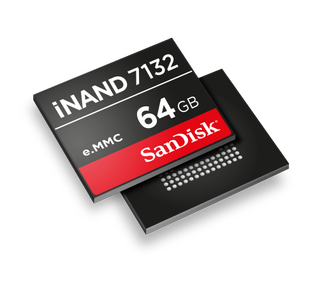SanDisk Releases Hybrid iNAND 7132 For Mobile Devices
SanDisk announced its new iNAND 7132 at the Mobile World Congress in Barcelona, Spain. This speedy storage for mobile devices comes in capacities up to 64 GB and features impressive performance specifications.
The diminutive iNAND 7132 measures just 11.5 mm x 13 mm and comes as slim as 0.8 mm. iNAND still packs quite the punch with up to 280/125 MB/s of sequential read/write speed on tap. The increased sequential speed is essential for the expanding performance requirements of mobile devices, and the iNAND 7132 can easily handle 4K Ultra HD video recordings and shoot RAW images at 3 FPS. Random IOPS weigh in at 3300/2800 read/write, which fuels storage responsiveness to speed up everyday tasks, such as launching apps and downloading content.

The bulk of the storage on the device is 1Y nanometer 3-bit TLC NAND, which is much more economical than typical MLC NAND, but does not provide as much endurance. TLC is also denser than MLC, which is important for slim mobile devices.
To bring the density and cost-effectiveness of TLC, without compromising performance or endurance, SanDisk employs a small SLC NAND layer in tandem with its SmartSLC technology, which is built on SanDisk's Accelerator Architecture platform. The SLC layer identifies and catches high speed traffic. It then passes it down to the TLC. This reduces wear on the TLC NAND, and has the additional benefit of providing fast burst speeds. A hybrid caching mechanism is perfect for mobile devices, which tend to have bursty workloads. iNAND 7132 can handle 24x7 use for 10 years, which is much longer than anyone will continue to use a mobile phone or tablet.
The embedded NAND space is very competitive as the NAND fabs vie for a slice of the lucrative and expanding mobile market. SanDisk's iNAND 7132 utilizes eMMC 5.0+, and early last month Samsung released an embedded NAND package that touts the new eMMC 5.1. These two storage devices will compete for different portions of the high/mid/low-end markets.
eMMC continues to be the de facto specification of choice for mobile storage, but another new competitor is waiting in the wings. Marvell flaunted its new NVMe-powered designs at Storage Visions 2015. Marvell displayed its NVMe controller embedded in Toshiba flash, which gives us a glimpse of other NAND fabs intentions in the future.
eMMC has already expanded to version 5.1 and other upgrades are in the works, so it will compete with NVMe in the future. This should make for an interesting competition in the mobile storage segment.
Stay on the Cutting Edge
Join the experts who read Tom's Hardware for the inside track on enthusiast PC tech news — and have for over 25 years. We'll send breaking news and in-depth reviews of CPUs, GPUs, AI, maker hardware and more straight to your inbox.
Follow Paul Alcorn @PaulyAlcorn. Follow us @tomshardware, on Facebook and on Google+.
3/4/2015 - Clarified that the caching mechanism catches all high speed traffic.

Paul Alcorn is the Managing Editor: News and Emerging Tech for Tom's Hardware US. He also writes news and reviews on CPUs, storage, and enterprise hardware.
-
zahoome "iNAND 7132 can handle 24x7 use for 10 years, which is much longer than anyone will continue to use a mobile phone or tablet."Reply
People are still using classic, indestructible Nokias, like the 3310 from 2000. That's 15 years and counting. Both my brother-in-law and mother-in-law had one that they were using until only a couple years ago. Granted, these phones aren't in constant use 24x7, but you can't claim 10 year old hardware isn't still used. That's very abundantly clear with computer hardware and it'll be true for mobile. Maybe not to the same extent, but still true. -
zahoome Google is your friend:Reply
"SanDisk Corporation today announced it has begun customer sampling of flash memory products based on its industry-leading 1Ynm process technology, which represents its second generation 19 nanometer (nm) manufacturing technology." -
Maxx_Power It would be nice if someone implemented a TLC-SLC fallback. Cells that are too worn to be used in TLC mode can dynamically switch to SLC mode so you will increase endurance at the expense of capacity in a very gradual way.Reply -
PaulAlcorn I actually asked if that is possible in a call with a different manufacturer, They explained that the switch has to be made early in the life cycle of the NAND cell, usually within the first few hundred P/E cycles. After that, any damage to the cell is done and is irreversible, so switching to SLC mode wouldn't help. I thought that rather odd, theoretically the SLC mode would not stress the cell as much as using it as TLC. But for now, it isn't possible that I am aware of.Reply -
Nuckles_56 Reply15411844 said:Google is your friend:
"SanDisk Corporation today announced it has begun customer sampling of flash memory products based on its industry-leading 1Ynm process technology, which represents its second generation 19 nanometer (nm) manufacturing technology."
Cheers, I was wondering if it was a typo or an actual process -
ammaross Reply15411844 said:Google is your friend:
"SanDisk Corporation today announced it has begun customer sampling of flash memory products based on its industry-leading 1Ynm process technology, which represents its second generation 19 nanometer (nm) manufacturing technology."
Cheers, I was wondering if it was a typo or an actual process
"1Y" is their way of saying "we're sub 20nm, but not as much as the 14nm people, and we don't want to admit it openly."
Most Popular





